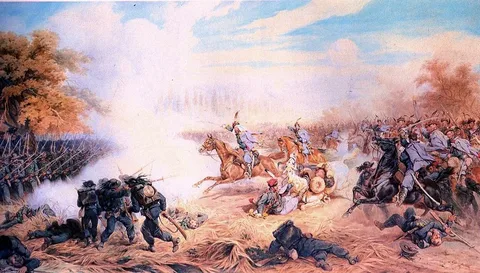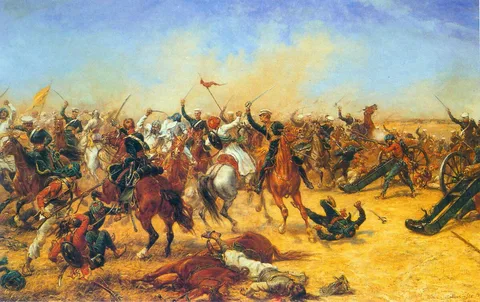The Battle of Bani Saleem, also known as the Al Kudr Invasion, was a significant early military expedition led by Prophet Muhammad (peace be upon him) in the year 2 Hijri (624 AD). It occurred shortly after the Muslims’ historic victory in the Battle of Badr and played a crucial role in consolidating the security of the nascent Muslim community in Medina.
The battle of Bani Saleem

-
Timing: The battle took place approximately one week after the Battle of Badr, in the month of Shawwal, 2 Hijri (624 AD).
-
Location: The confrontation occurred near a watering place called Al Kudr, situated in the territory of the Banu Saleem tribe.
-
Threat: Intelligence reached the Prophet Muhammad that the Banu Saleem and Ghatafan tribes were gathering forces with the intention to attack Medina.
-
Strategic Importance: The Banu Saleem and Ghatafan tribes were powerful groups in the Arabian Peninsula. Their potential attack posed a direct threat to the security and stability of the Muslim community in Medina.
Read more: The battle of Waddan (1 Hijri)
Objectives of the Expedition
The primary objectives behind the Battle of Bani Saleem were:
-
Pre-emptive Defense: To prevent the planned invasion of Medina by the Banu Saleem and Ghatafan tribes.
-
Deterrence: To send a clear message to hostile tribes that the Muslims were prepared to defend themselves and retaliate if threatened.
-
Consolidation of Power: To strengthen the position of the Muslim community after their victory at Badr by neutralizing immediate threats.
-
Protection of Medina: To ensure the safety of the Muslim population and maintain the security of the city.
The Muslim Army and Leadership
-
Commander: Prophet Muhammad (PBUH) personally led the expedition.
-
Army Size: Approximately 200 Muslim fighters participated.
-
Leadership in Medina: During the Prophet’s absence, leadership and justice in Medina were entrusted to Sa’d bin Arfatah or Abdullah bin Umm Maktum according to different historical accounts.
-
Flag-bearer: The flag of the Muslim army was carried by Ali ibn Abi Talib (may Allah be pleased with him), the Prophet’s cousin and a key companion.
Read about: The battle of Bawat (2 Hijri)
The Course of the Battle
-
The Muslim army marched towards the gathering point of the Banu Saleem and Ghatafan tribes at Al Kudr.
-
Upon hearing of the approaching Muslim forces, the tribes were seized by panic and fear.
-
Instead of engaging in battle, the Banu Saleem and Ghatafan fighters fled to the mountain summits, abandoning their camp and belongings.
-
The Prophet sent scouts to survey the area, who found only camel herders and shepherds left behind, including a young boy named Yasar.
-
The Muslims seized 500 camels left behind by the fleeing tribes as war booty.
Results and Spoils of War
-
No actual fighting occurred during the battle as the enemy fled.
-
The Muslims captured 500 camels, which were distributed among the companions.
-
The Prophet set aside one-fifth of the spoils as Khums (a religious tax).
-
Among the spoils was a young boy, Yasar, who was given to the Prophet and later emancipated after he embraced Islam and learned to pray.
-
The Prophet and his army stayed at Al Kudr for three days, waiting for any return of the enemy, but none appeared.
-
The expedition ended with a Muslim victory by deterrence.
Recommend: The battle of Al-Asherah (2 Hijri).
Significance of the Battle of Bani Saleem
-
This expedition was the first military encounter after the Battle of Badr, reinforcing the momentum of the Muslim community.
-
It demonstrated the Prophet’s strategic approach of pre-emptive defense and psychological warfare by intimidating potential enemies.
-
The event is classified as a Ghazwah (military expedition) in Islamic history, even though no actual combat took place, because it involved the Prophet’s direct leadership and mobilization of the Muslim army.
-
The battle helped to secure the borders of Medina and deter future attacks by hostile tribes.
-
It strengthened the morale and unity of the Muslim community by showing their readiness and resolve.
Key Personalities Involved in the Battle of Bani Saleem
Several important figures played significant roles during the Battle of Bani Saleem:
-
Prophet Muhammad (PBUH): He was the main commander and leader of the Muslim army, personally leading the expedition.
-
Ali ibn Abi Talib (RA): He carried the flag of the Muslim army and was one of the prominent military leaders.
-
Sa’d bin Arfatah or Abdullah bin Umm Maktum: One of these two was appointed to govern Medina during the Prophet’s absence, according to different historical sources.
-
Yasar: A young boy captured as part of the spoils of war, who was later freed by the Prophet after embracing Islam.
Lessons and Reflections
-
The battle illustrates the importance of intelligence and reconnaissance in warfare.
-
It shows the effectiveness of psychological tactics—the mere approach of the Muslim army caused the enemy to flee.
-
The Prophet’s decision to emancipate Yasar reflects the Islamic principle of mercy and kindness even in times of conflict.
-
The expedition emphasizes the balance between military preparedness and ethical conduct in Islam.
FAQs
When did the Battle of Bani Saleem take place?
It took place in 2 Hijri (624 AD), about one week after the Battle of Badr, during the month of Shawwal.
Who were the opponents in this battle?
The Muslim army faced the Banu Saleem and Ghatafan tribes, who were gathering to attack Medina.
Was there any actual fighting in the Battle of Bani Saleem?
No, the enemy tribes fled upon hearing of the Muslim army’s approach, so no direct combat occurred.
What was the outcome of the battle?
The Muslims captured 500 camels left behind by the fleeing tribes and returned to Medina victorious without bloodshed.
Why is this event considered a battle if no fighting took place?
It is considered a Ghazwah because the Prophet personally led the expedition and mobilized the army, fulfilling the criteria of a military campaign.
Conclusion
The Battle of Bani Saleem, although not involving direct combat, was a strategically important expedition led by Prophet Muhammad (PBUH) in 2 Hijri. It demonstrated the Prophet’s wisdom in using intelligence, pre-emptive action, and psychological tactics to protect the Muslim community of Medina from imminent threats. The swift retreat of the enemy tribes without fighting highlighted the effectiveness of the Muslim army’s presence and resolve. Moreover, the humane treatment of captives and fair distribution of spoils reflected the ethical principles that guided the Prophet’s leadership.

